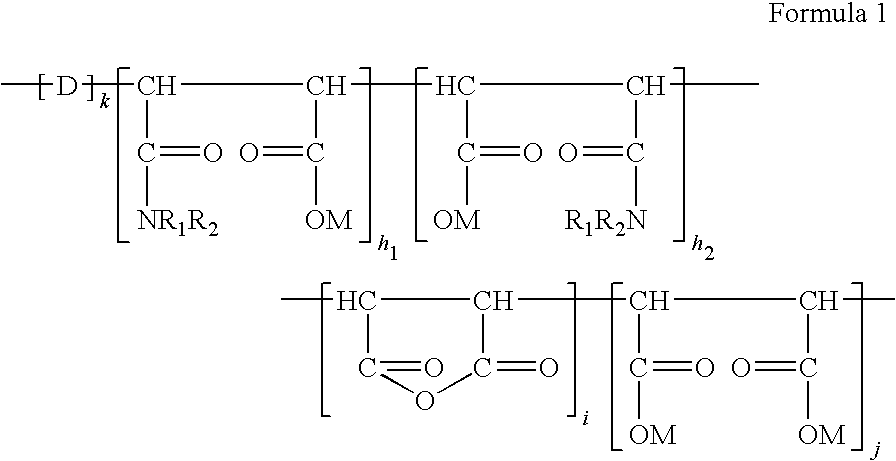Copolymers for stain resistance
a technology of copolymer and stain resistance, which is applied in the direction of detergent compounding agent, weaving, synthetic resin layered product, etc., can solve the problems of not revealing or suggesting the use of such compositions for staining, troublesome acid dyes present in such agents, and difficult to achieve the effect of imparting the resistance to staining
- Summary
- Abstract
- Description
- Claims
- Application Information
AI Technical Summary
Benefits of technology
Problems solved by technology
Method used
Image
Examples
example 1
[0065]To a one liter four neck round bottom flask equipped with an overhead stirrer, condenser with nitrogen inlet, temperature probe and addition funnel, was added styrene maleic anhydride copolymer (SMA) (25 g, 124 mmol) 1000 flake and acetone (300 mL). 4-Aminosalicylic acid (0.95 grams, 6.2 mmol) and triethylamine, (0.78 gm, 1.2:1 molar ratio to 4-aminosalicylic acid, 7.7 mmol) were dissolved in 50 mL of deionized water and added slowly to the reaction, followed by refluxing for 3 hours. Rotary evaporation of the acetone gave the crude product in water (135 g, 19% solids). The above solution and sodium hydroxide (2 molar equivalents to SMA (9.9 grams) in 50 mL water) were heated in a 1 L round bottom flask at 70° C. for 3 hours. The solution was cooled, acidified, and filtered to yield 40.2 grams of light yellow powder. The product (4 grams) was dissolved in basic water by refluxing to give a solution (58.6 g, 6.8% solids). Theory C, 64.78; H, 6.27; N, 0.31. Found C, 63.36; H, 5....
example 2
[0066]The process of Example 1 was employed using styrene maleic anhydride copolymer (SMA) 1000 (25 g, 124 mmol), 4-aminosalicylic acid (1.9 g, 12.4 mmol), and triethylamine (1.51 g). The solution of the resulting product prepared for testing had a solution wt. of 52.4 grams and 7.6% solids. Theory C, 64.70; H, 6.20; N, 0.59. Found: C, 60.91; H, 5.61; N, 0.71. The solution was applied to the light blue carpet substrate using the Application Method described above. The carpet was tested for resistance to staining with KOOL-AID and coffee according to Test Methods 1 and 2, and durability of stain resistance according to Test Method 3. Results are in Table 1.
example 3
[0067]The process of Example 1 was employed using styrene maleic anhydride copolymer (SMA) 1000 (25 g, 124 mmol), triethylamine (4.56 g), and 4-aminosalicylic acid (5.76 g, 37.6 mmol). The solution of the resulting product prepared for testing had a solution wt. of 52.4 grams and 7.6% solids. Theory C, 64.41; H, 5.91; N, 1.75; Found C, 63.58; H, 5.650; N, 1.22. The solution was applied to the light blue carpet substrate using the Application Method described above. The carpet was tested for resistance to staining with KOOL-AID and coffee according to Test Methods 1 and 2. Results are in Table 1.
PUM
| Property | Measurement | Unit |
|---|---|---|
| temperatures | aaaaa | aaaaa |
| temperatures | aaaaa | aaaaa |
| temperatures | aaaaa | aaaaa |
Abstract
Description
Claims
Application Information
 Login to View More
Login to View More - R&D
- Intellectual Property
- Life Sciences
- Materials
- Tech Scout
- Unparalleled Data Quality
- Higher Quality Content
- 60% Fewer Hallucinations
Browse by: Latest US Patents, China's latest patents, Technical Efficacy Thesaurus, Application Domain, Technology Topic, Popular Technical Reports.
© 2025 PatSnap. All rights reserved.Legal|Privacy policy|Modern Slavery Act Transparency Statement|Sitemap|About US| Contact US: help@patsnap.com



